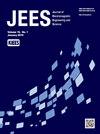Hybrid Sidelobe Recognition Method Using Boresight Error and Quadrant Signal Difference for Monopulse Array
IF 1.7
3区 工程技术
Q3 ENGINEERING, ELECTRICAL & ELECTRONIC
Journal of electromagnetic engineering and science
Pub Date : 2023-09-30
DOI:10.26866/jees.2023.5.r.185
引用次数: 0
Abstract
In this paper, a sidelobe recognition method using boresight error and quadrant signal difference for a monopulse array is proposed. A conventional sidelobe recognition method compares the difference between the sum and delta channels. This method works well for the azimuth and elevation planes. However, the method is prone to many errors in the diagonal region of the two-dimensional plane. To overcome this problem, a method to calculate the deviation of the boresight error difference with different frequency combinations and a threshold to identify the sidelobe is proposed, and the method is validated to significantly reduce the error region. If a four-quadrant signal can be extracted separately, the signal deviation can be calculated and compared with the threshold, and the error region can be further reduced. The effects of each margin and bandwidth on the recognition performance are analyzed, and a slot array antenna is simulated to assess the method’s effectiveness.基于轴视误差和象限信号差的单脉冲阵列混合旁瓣识别方法
提出了一种基于轴视误差和象限信号差的单脉冲阵列旁瓣识别方法。传统的旁瓣识别方法比较和信道和增量信道之间的差异。这种方法适用于方位角和仰角平面。然而,该方法在二维平面的对角线区域容易产生许多误差。为了克服这一问题,提出了一种计算不同频率组合下视轴误差差的偏差和识别副瓣的阈值的方法,并对该方法进行了验证,使误差区域显著减小。如果可以单独提取四象限信号,则可以计算信号偏差并与阈值进行比较,进一步缩小误差区域。分析了各裕度和带宽对识别性能的影响,并对一个槽阵天线进行了仿真,验证了该方法的有效性。
本文章由计算机程序翻译,如有差异,请以英文原文为准。
求助全文
约1分钟内获得全文
求助全文
来源期刊

Journal of electromagnetic engineering and science
ENGINEERING, ELECTRICAL & ELECTRONIC-
CiteScore
2.90
自引率
17.40%
发文量
82
审稿时长
10 weeks
期刊介绍:
The Journal of Electromagnetic Engineering and Science (JEES) is an official English-language journal of the Korean Institute of Electromagnetic and Science (KIEES). This journal was launched in 2001 and has been published quarterly since 2003. It is currently registered with the National Research Foundation of Korea and also indexed in Scopus, CrossRef and EBSCO, DOI/Crossref, Google Scholar and Web of Science Core Collection as Emerging Sources Citation Index(ESCI) Journal. The objective of JEES is to publish academic as well as industrial research results and discoveries in electromagnetic engineering and science. The particular scope of the journal includes electromagnetic field theory and its applications: High frequency components, circuits, and systems, Antennas, smart phones, and radars, Electromagnetic wave environments, Relevant industrial developments.
 求助内容:
求助内容: 应助结果提醒方式:
应助结果提醒方式:


